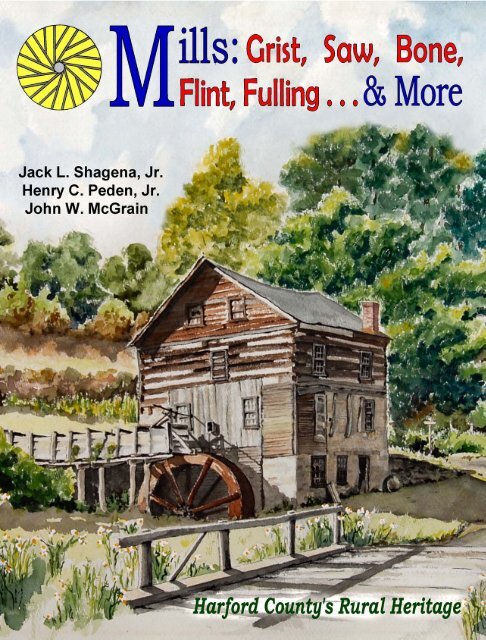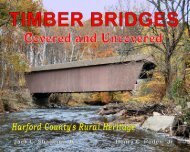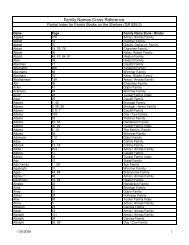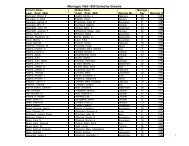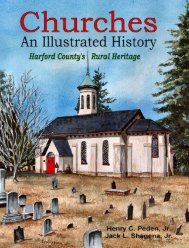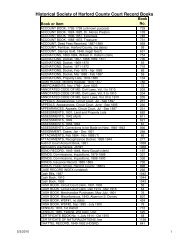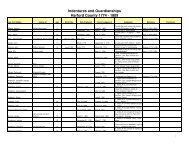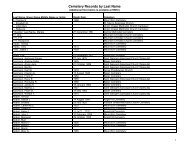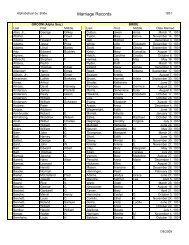Untitled - THE HISTORICAL SOCIETY OF HARFORD COUNTY ...
Untitled - THE HISTORICAL SOCIETY OF HARFORD COUNTY ...
Untitled - THE HISTORICAL SOCIETY OF HARFORD COUNTY ...
You also want an ePaper? Increase the reach of your titles
YUMPU automatically turns print PDFs into web optimized ePapers that Google loves.
Table of Contents<br />
Introduction .....................................................................................................................7<br />
Preface ...............................................................................................................................8<br />
Acknowledgements ........................................................................................................9<br />
About the Authors .......................................................................................................10<br />
1. Grain Milling – A Short History ...........................................................................11<br />
Querns .......................................................................................................................12<br />
Stump Milling...........................................................................................................12<br />
Horizontal Water Wheel .........................................................................................13<br />
Vertical Water Wheel...............................................................................................14<br />
Mill Automation.......................................................................................................15<br />
Steel Roller Milling ..................................................................................................16<br />
2. Early Maryland Settlement ....................................................................................17<br />
Founding of Maryland ............................................................................................18<br />
Tobacco Plantation Economy .................................................................................19<br />
Dispelling a Myth................................................................................................19<br />
The Middling Planter .........................................................................................20<br />
3. Early Grist Milling in Harford County................................................................23<br />
Geology and Water Power......................................................................................23<br />
Harford’s Earliest Mill.............................................................................................24<br />
Writ of Ad Quod Damnum .......................................................................................25<br />
State of Milling in the Mid‐18 th Century ...............................................................26<br />
First Harford County Merchant Flour Mill ..........................................................28<br />
Jerusalem – A Merchant Mill..................................................................................31<br />
Rock Run Mill – Flour on the Susquehanna.........................................................34<br />
4. Other County Grist Mills Still Standing.............................................................39<br />
The Wiley Mills of Northwest Harford ................................................................40<br />
Wiley’s Lower Deer Creek Mill (Ivory Mills) ..................................................40<br />
Wiley’s Upper Mill (on Jolly Acres Road) ........................................................43<br />
Amos’ Mill..............................................................................................................46<br />
Deer Creek Upper Mills...........................................................................................51<br />
Eden Mill ................................................................................................................51<br />
Walter’s Mill ..........................................................................................................56<br />
Deer Creek Lower Mills ..........................................................................................61<br />
Wilson’s Mill..........................................................................................................61<br />
Noble’s Mills: Grist Mill and Saw Mill...............................................................64<br />
Cookville – A Village............................................................................................68<br />
Columbia Woolen Mills ....................................................................................68<br />
Tanbark Mill .......................................................................................................71<br />
Tannery................................................................................................................72
Table of Contents<br />
Winters Run and Tributaries .................................................................................75<br />
Whitaker Mill.........................................................................................................75<br />
Chrome Valley Mill...............................................................................................78<br />
Other Creeks and Tributaries.................................................................................85<br />
Mill Green Mill ......................................................................................................85<br />
Fishel’s Mill............................................................................................................87<br />
Breuninger’s Tannery and Tanbark Mill ...........................................................90<br />
Deep Run Mill .......................................................................................................92<br />
Powered by Steam and Electricity ........................................................................97<br />
Bel Air Roller Mills................................................................................................97<br />
Tharpe & Green, Inc........................................................................................... 102<br />
The Mill of Whiteford at Cardiff...................................................................... 103<br />
5. Other Types of Mills in Harford County ......................................................... 105<br />
Saw Mills ................................................................................................................ 105<br />
Fulling Mills........................................................................................................... 108<br />
Woolen Mills.......................................................................................................... 108<br />
Bark Mills ............................................................................................................... 109<br />
Flint Mills ............................................................................................................... 109<br />
Bone Mills............................................................................................................... 112<br />
Cider Mills.............................................................................................................. 112<br />
Sorghum/Molasses Mills...................................................................................... 113<br />
Paper Mills ............................................................................................................. 114<br />
Oil Mills .................................................................................................................. 115<br />
Plaster Mills ........................................................................................................... 115<br />
Other Mills ............................................................................................................. 116<br />
6. Water Drove Mills That Grew Villages............................................................ 119<br />
Jerusalem Mill Village .......................................................................................... 120<br />
Rock Run Village................................................................................................... 121<br />
Clermont Mills Village ......................................................................................... 122<br />
Mill Green Village................................................................................................. 122<br />
Milford Mills Village ............................................................................................ 123<br />
7. A Digest of Harford County Mills..................................................................... 125<br />
Appendix: Millwrights, Millers, and Mill Owners............................................ 287<br />
Index and Cross‐reference....................................................................................... 295<br />
2
Introduction<br />
In America, Maryland, and Harford County, mills powered by water,<br />
represented the latest in industrial technological development during the 1600s<br />
to about the mid 1800s. They were, in today’s terminology, on the high‐tech<br />
cutting edge of what could be done. Mills were used to grind grain into food,<br />
saw logs into lumber, press seeds into oil, grind bones into fertilizer, pump air<br />
into iron furnaces and the list goes on. Water moving downhill provided the<br />
requisite horsepower to free animals, and more importantly humans, from<br />
physically demanding burdens, thereby improving the quality of life for most.<br />
Heretofore, the study of Harford County milling has focused on the<br />
chronological ownership of individual mills and has not been framed in the<br />
context of overall population growth and the attendant development of hamlets<br />
or villages. Our effort seeks to draw these parallels and presents some of the<br />
“how” about mill operation.<br />
The locations of still‐standing mills have been<br />
identified (with permission) on an individual grid of<br />
the 2009 ADC Harford County Street Atlas (see<br />
example at right). The mill is identified with a red<br />
water wheel and the map grid can be found on the<br />
page number (now four‐digits) and coordinates<br />
shown in black, such as ADC 4241 H2. Many mill<br />
ruins have been located as well and while photo are<br />
presented showing some of the remains, the location<br />
have not been revealed to protect these sites from<br />
unwanted intrusions.<br />
In Harford County and elsewhere, there were a large variety of mills as reflected<br />
in the title of this book. In many cases, the word mill was preceded by the<br />
product being milled, for example, grain, flint, bark, sorghum, and bone. As<br />
grain was usually done in batches for individual farmers, a batch was called<br />
grist; hence, the familiar expression grist mill for a grain mill. In other cases, the<br />
mill was identified based on its output such as a flour mill, cider mill, and oil<br />
mill (really a seed mill). Logically, a saw mill should have been called a log or<br />
lumber mill, but for historical reasons common names have been used.<br />
What may be of interest to the reader are the varied backgrounds of the three<br />
authors. One has studied and written about mills since 1968, another is a noted<br />
Maryland genealogist, and the other one has an engineering background. Each<br />
brought a unique perspective to the writing table and the ensemble is a<br />
synergistic compilation that was only possible by melding different viewpoints.
Preface<br />
This book is the fifth in a series focusing on Harford County’s rural heritage (see<br />
list on page 2) and the authors are delighted to have intrepid molinographer John<br />
McGrain join this effort. John is Maryland’s leading authority on mills and has<br />
written about Harford County mills in two Bulletins published by the Historical<br />
Society of Harford County in 1998 and 1999.<br />
Many mills were located in idyllic<br />
settings that conjure up pastoral<br />
visions of rippling mill races,<br />
horses laden with bags of grain to<br />
be ground, and the hubbub and<br />
activity that spawned the familiar<br />
countryside expression of milling<br />
around (see Currier and Ives print at<br />
right). Often near the mill were<br />
other valuable services such as a<br />
blacksmith, cobbler, or perhaps a<br />
general store that added to the excitement of the occasional visit.<br />
At the peak of these activities near the end of the nineteenth century there were<br />
almost 100 mills operating in the county with the most prevalent type being flour<br />
or grain mills. Starting about 1870, the introduction of steel rollers milling<br />
gradually rendered stone grinding obsolete and – along with the opening of the<br />
mid‐west grain‐growing plains – the manufacturing of wheat into flour moved<br />
northwest to cities like Rochester, New York then west to Minneapolis,<br />
Minnesota. About 1970 the last Harford County grain mill for human food<br />
closed.<br />
Fortunately, the State of Maryland has preserved two old Harford County mills<br />
with another one owned by the county having been restored by volunteers.<br />
Private individuals, as well, have helped, as other mills have been preserved as<br />
dwellings and in one case a business. Where extant, they have been<br />
photographed and included herein along with a number of mill ruins.<br />
Early on, the location of a water‐powered facility was called “mill seat” that<br />
generally remained the same from generation to generation. Mill owners and<br />
millers, however, did rotate through causing the business name to change<br />
leading to much confusion. The authors have strived to identify the mill seats on<br />
a map, to which the descriptions are tied.<br />
Chapters 1 through 6 provide an overview of mill operations in the county from<br />
the earliest time to today. Chapter 7 is an alphabetical listing of all mills by the<br />
most well known name with cross‐references to other names.<br />
2


